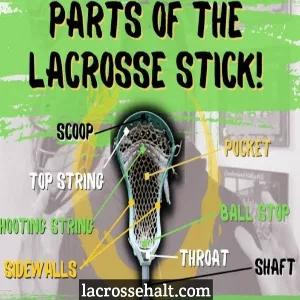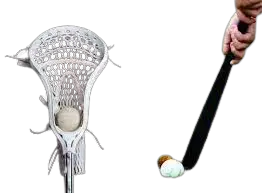What Are The Parts Of A Lacrosse Stick

What Are The Parts Of A Lacrosse Stick ?The words “head,” “shaft,” “pocket,” and “butt end” may not have much meaning alone, but when combined, they form a lacrosse stick!
The stick is an extension of the player in lacrosse, so knowing its components is essential to being able to catch, throw, shoot, and choose a lacrosse stick that fits your style. The components of a lacrosse stick can vary in size and shape depending on your position and skill level, but they all have a few basic parts. Without further ado, let's examine each part of a lacrosse stick and why it matters to every player.
What are the parts of a lacrosse stick ?
- Lacrosse Head: The pocket, or netting that holds the lacrosse ball, is located in the lacrosse head, which is positioned at the top of the stick.
- Lacrosse Shaft: The long, pole-like portion of the lacrosse stick is called the lacrosse shaft.
- Lacrosse Pocket: The mesh netting where the ball sits on the head is called a lacrosse pocket.
Lacrosse head:
One of the most important components of a lacrosse stick is the head. The head carries, tosses, shoots, catches, and passes the ball. It is composed of a sidewall and a scoop. For every kind of player, lacrosse heads are made of various materials, patterns, sizes, and shapes.
Lacrosse head scoop:
The scoop, which is used to lift the lacrosse ball off the ground, is located on top of the lacrosse head. The scoop is almost flat and can be bent. Players who are still learning the fundamentals of the game usually use the flat-style scoop, which forces them to lower themselves to the ground to retrieve the ball. For improved accuracy while passing or shooting, a curved scoop can help channel the ball.
Lacrosse head side wall:
The term “sidewall” refers to the side of the lacrosse head. The lacrosse head and strings are connected by sidewall holes. Depending on the player's position and from head to head, the distance between each sidewall varies:
- Because defensive heads are wider, attacking passes can be easily knocked out of the air. To be more durable and allow defenders to deliver hard checks without breaking skulls, defensive sidewalls are likewise thicker.
- Narrower attack heads enable improved ball control. Because the sidewalls are frequently thinner, the head is lighter and moves more quickly. Attackmen may now cradle, dodge, pass, and shoot the ball with control and ease thanks to this.
- The heads of midfield lacrosse are of mixed breed. Although they are powerful enough to do defense work, they are lightweight for shooting and handling.
- The widest among them are goalie heads. Goalie sticks have wide heads to increase the likelihood of capturing the ball and making a save.
Additionally, sidewalls have stringing holes that run parallel to the head. You can thread a lacrosse pocket that retains the ball within the head using these stringing holes.
Lacrosse head material:
Traditionally, lacrosse sticks were fashioned from a single, bent piece of wood. The hard plastic used to make modern lacrosse heads is called nylon resin, and it is melted and molded.
Despite sharing the same material, the various heads provide varying degrees of rigidity or flexibility. Softer, more flexible heads are more appropriate for midfielders and forwards grabbing ground balls, while stiffer defense heads are usually more useful for hard, forceful checks.
More plastic was used to make the skull, adding weight and causing stiffness. On the other hand, reduced weight and thinner sidewalls due to flexibility make ground balls more difficult to grab.
Lacrosse shaft:
One of the essential components of a lacrosse stick that affects range, power, accuracy, and speed is the lacrosse shaft. The position of the player determines the shaft length.
Defense sticks, for instance, are significantly longer than offensive and midfielder shafts, which are around half as large. Players should also think about the weight of their lacrosse shafts. Attackers can move more quickly with lighter shafts, while defensive players benefit from heavier shafts' strength and longevity.
Lacrosse shaft material:
- Aluminium is a cheap material that will dent with more experienced play, making it perfect for beginning players.
- Alloy metals: Made of a combination of metals, these shafts are inexpensive, lightweight, and lightweight.
- Scandium: More strength than alloy, scandium is a common material for lacrosse shafts and offers a high strength-to-weight ratio. It is suitable for every role.
- Composite: Composite shafts are ideal if you wish to select flex accurately. Like hockey sticks, they are composed of carbon fiber and come in a range of flex profiles.
- Blends: To achieve the ideal strength and weight, blended shafts use a variety of the aforementioned materials; yet, none will be as light as an unblended material.
Lacrosse shaft length:
A lacrosse shaft's length changes according to the position:
- Midfield and attack shafts are normally about 30 inches long.
- Generally speaking, defensive lacrosse shafts measure about 60 inches in length.
- Goalie lacrosse shafts are usually 36 inches long, but as you get closer to college and professional leagues, goalie stick lengths can vary significantly. Goalies, for instance, may prefer a somewhat longer stick length as they grow bigger.
U10 young leagues have drastically reduced stick lengths.
Lacrosse shaft end butt:
The end cap also called the lacrosse butt end, is a little plastic or rubber cap that attaches to the end of your lacrosse shaft. The purpose of the butt end is to shield players from the sharp or potentially hazardous lacrosse shaft tip if it is exposed. Securing hand placement also benefits from the use of butt ends. The butt end acts as a stopper for your bottom hand when you slide your hands up and down the shaft, enabling you to change into a pass or a shot faster.
Lacrosse pocket:
Lacrosse shooting strings, sidewall strings, and mesh make up the lacrosse pocket. The purpose of the pocket, which is where the ball sits, is to provide the player with control when cradling. A lacrosse player's style, skill level, preference, and position all affect how the pocket is strung. There are a few options: mid pockets (the best of both worlds), low pockets (excellent for control), and high pockets (perfect for quick release).
The best lacrosse players depend on a solidly formed pocket. An uptight pocket can hinder a player's lacrosse ball passing, shooting, and cradling abilities. What Are The Parts Of A Lacrosse Stick
Lacrosse pocket depth:
The pocket in lacrosse can only be a specific depth. The men's lacrosse regulations state that if the top surface of a lacrosse ball is below the bottom border of the sidewall when the ball is held horizontally in the stick, the pocket will be considered to have sagged too deeply (goalkeepers are exempt from this rule). The pocket must also be fully fixed to the head and side walls, with no spaces big enough for a ball to become stuck or pass through.
Lacrosse mesh:
The strings that create a diamond pattern in the pocket are called lacrosse mesh. The pocket's base is lacrosse mesh, which is available in multiple varieties:
- Performance mesh: This is a designation rather than a specific style, even though it is constructed of better materials. The term “mesh” can apply to either soft or hard mesh; it describes the fibers that provide durability and grip.
- Wax mesh: A silky grip mesh that improves hold with less whipping and speeds up shots by lowering resistance. Stringing can be challenging, though, as the wax may remain on your sidewalls after play.
- Soft mesh: Many offensive players choose this because it is ready to use right out of the packaging. It provides good ball control and is simple to work with, although it will eventually stretch.
- Hard mesh: An old favorite, this type of mesh becomes better with age. Although there is very little “give,” this is the best option for durability but takes some getting used to and skill to operate.
- Six-diamond mesh: Compared to regular 10-diamond mesh, this mesh has smaller diamonds, making it a tighter weave that is easier to break in and become used to. Although stringing might be challenging, it provides good handling.
Women's lacrosse stick:
The head, shaft, pocket, and butt end of a women's lacrosse stick are all the same as those of a men's stick; the pocket, however, is distinct. The top of the lacrosse ball must be visible over the top of the entire sidewall when it is placed into the pocket of a stick held horizontally, according to women's lacrosse rules. A women's lacrosse stick's pocket depth is therefore substantially shallower than a men's lacrosse stick's pocket depth.
FAQs: What Are The Parts Of A Lacrosse Stick
Q1: What are the main components of a lacrosse stick?
A standard lacrosse stick consists of three main parts: the head, the shaft, and the pocket. Each part plays a vital role in the player's performance on the field.
Q2: What materials are commonly used to make lacrosse stick heads?
Lacrosse stick heads are typically made from materials like plastic, rubber, or metal alloys. Advanced models might incorporate composite materials for enhanced durability and performance.
Q3: Can I customize the pocket of my lacrosse stick?
Yes, lacrosse players often customize their stick pockets to suit their playing style. Stringing techniques and pocket depth can be adjusted to enhance ball control and accuracy.
Q4: What is the purpose of the shooting strings on a lacrosse stick?
Shooting strings, usually made of nylon, help control the release of the ball during a shot, contributing to accuracy and speed. Players often adjust shooting strings to achieve their desired shooting style.
Q5: Are there regulations regarding the length of lacrosse stick shafts?
Yes, lacrosse governing bodies have specific regulations regarding the length of shafts for different player positions. It’s essential to adhere to these regulations to participate in official games.
Q6: How do I clean and maintain the mesh pocket of my lacrosse stick?
Cleaning the mesh pocket involves gentle scrubbing with mild detergent and water. Regular maintenance, such as removing dirt and moisture, helps prolong the life of the mesh and ensures optimal performance.
Q7: Can lacrosse stick heads be used interchangeably with different shafts?
Yes, most lacrosse stick heads have a universal design, allowing them to fit various shafts. However, it's crucial to check compatibility, especially when replacing parts.
Q8: What is the significance of the sidewall in a lacrosse stick head?
The sidewall provides structural support to the lacrosse stick head, contributing to its overall durability and stability. It helps maintain the shape of the head during intense gameplay.
Can I replace individual parts of my lacrosse stick if they get damaged?
Yes, many lacrosse stick parts are replaceable. Heads, shafts, and strings can often be replaced individually, allowing players to maintain their stick's performance without purchasing an entirely new one.
Q10: How often should I rest my lacrosse stick?
The frequency of restringing depends on usage and personal preference. Players who use their sticks frequently might need to restring more often, especially if they notice a decline in performance or pocket integrity.
Conclusions:
Understanding the intricate parts of a lacrosse stick is fundamental for players at all levels. The head, shaft, and pocket work harmoniously to influence ball control, accuracy, and overall gameplay. By comprehending the nuances of each part and its functions, players can make informed choices when selecting or customizing their lacrosse sticks.
Regular maintenance, including cleaning, restringing, and inspecting for wear and tear, is essential to ensure the longevity and optimal performance of a lacrosse stick. Customization, adhering to regulations, and proper care contribute to a player's confidence on the field, allowing them to focus on honing their skills and enjoying the game to the fullest.




